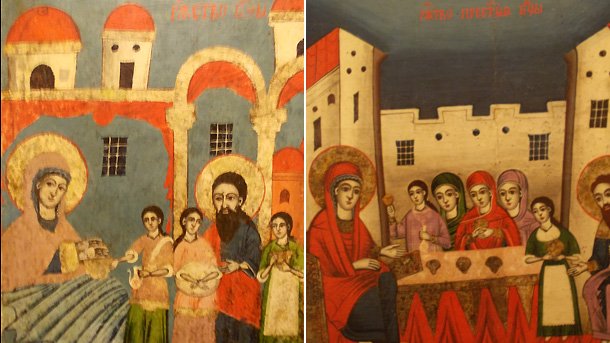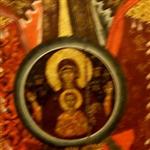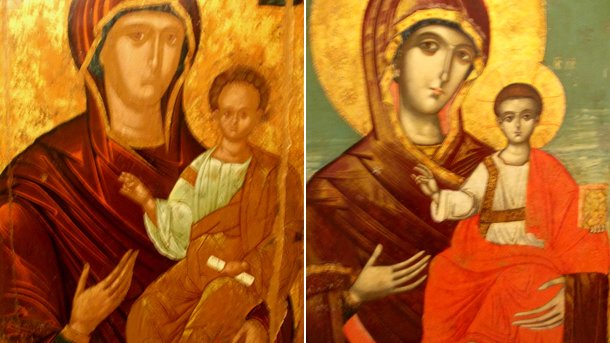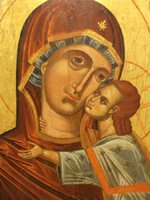On 8 September the Bulgarian Orthodox Church celebrates one of its biggest feasts, the Nativity of the Blessed Virgin Mary. On this occasion we bring you a few insights into the image of the Holy Virgin in the Bulgarian icon-painting tradition.

© Photo: Iliana Raicheva
The Crypt of St. Alexander Nevsky Cathedral keeps two icons dedicated to the Nativity of the Blessed Virgin. One of them is quite famous and its versions are seen in many churches in Bulgaria. Usually, Virgin Mary is depicted as a baby with a halo lying in a cradle or a cot placed in front of a solemnly laid table with guests. Her parents, St Anne and St. Joachim of Nazareth, are also seated at the table. The other icon is more of an exception in the Bulgarian tradition:
“Here the cradle in front of the table is missing, and little Virgin Mary has been painted on a icon that St. Anne holds in her hands to show to the guests”, explains Vladislava Kasamakova, a guide in the Crypt, Bulgaria’s leading icon-painting museum. “Besides, there is a red halo above the head of the Holy Virgin though she is still a baby. The red color has a special meaning in Orthodox icon-painting because it is awarded with a strong protective function. The red has replaced the green that until 10 c. symbolized the victory of life over death and denoted the high status of the depicted character in heaven. The artist aimed to make clear that Virgin Mary was selected for a paramount mission at her birth. She had to give birth to the Savior who in turn would save our sinful souls sacrificing his earthly life. Therefore, in all icons the Holy Virgin Mary looks
very serious and concentrated. Though blessed, she did not have an easy life. This is one of the differences between Orthodox Christian and Catholic art. Under the catholic tradition she is depicted in royal blue, denoting a high status, and plays with the little Jesus, who is an infant. The moment of maternal love has been captured in such works bringing a lot of happiness for every woman. In contrast in Orthodox art the interpretation of deep maternal feelings is always saturated with plenty of grief.”
It is believed that the first icon of the Blessed Virgin Mary was painted by Apostle Luke. Later on, as time went by, precise rules were elaborated for painting her image. The Holy Mother of God was always painted in two colors, read reaching the point of intense brown, and blue. The red color denotes the connection of the Holy Virgin with ordinary women, This is the color of femininity and motherhood. The blue color is the color of grief and mourning. It is only the Holy Virgin Mary that has the right to wear red shoes even beside the crucifix – because of her special position in heaven. Vladislava Kasamakova points to some of the most common canons for painting the Holy Virgin.

The oldest icon of Virgin Mary is Oranta, or “wider than heaven”. In this icon alone she is in a blessing position and is usually painted on the eastern side of churches. The most common painting style is known as Odigitria meaning Cynosure. Here is the reason: "It is so, because with her right hand, the Holy Virgin Mary points to us the way of our souls’ salvation. She points at her son Jesus Christ seated in her lap and giving blessing. Jesus Christ is depicted as a child but has no child countenance. In the Orthodox tradition He has got no age, and is the symbol of wisdom. He is eternal though He has taken up a human appearance for a while. The Father has given Him to us to make sure we can accept Him in a human dimension. On the forehead and on both shoulders of the Blessed Virgin, there are three stars that form a triangle. It symbolizes her innocence and virtue as well as motherhood. After all, the Holy Virgin proved she was not a sinner, and has been blessed from among all women to give birth to our Savior. It is quite characteristic of all icons of the Holy Virgin with the Infant that He is the one who blesses, and she is somewhat perceived as a background.”

© Photo: Iliana Raicheva
 One of the icon-painting cannons deeply venerated by women who hope to have a child is Eleusa meaning tenderness and love.
One of the icon-painting cannons deeply venerated by women who hope to have a child is Eleusa meaning tenderness and love.
“This is the icon in which Jesus Christ is hugging His mother at the neck, check to cheek, and it symbolizes maternal love”, Vladislava Kasmakova says further. “This is the single moment when the Holy Mother of God is allowed to smile. This icon became very popular in the Balkans and especially in Russia. We can rightfully claim that this is the most feminine icon. More often than not its versions are accepted as wonder working and are venerated in many churches. From this cannon another very popular cannon arose: the Three-Handed Holy Virgin. Usually the right hand of Virgin Mary is duplicated. The meaning of this cannon is that when loving someone, two hands are not enough to hug them.”
A most famous Three-Handed Holy Virgin is found at Troyan Monastery, Central Northern Bulgaria. There are other cases when a component of the icon has been duplicated. This makes such icons more deeply venerated, as it is believed that prayers said in front of them are twice as powerful. This is quite characteristic of the Bulgarian mentality.
“One example of duplication is the icon Blessed Virgin Mary Unfading Rose”, Vladislava Kasamakova explains. “Until 10 c. all saints were replaced with symbols. This was in part a protective policy that had survived from times when Christianity was still secret and its adherents were persecuted. And the rose is exactly an example of a symbol adapted from more ancient religions. This is the flower

favored by the Greek goddess Aphrodite. A edict issued in 843, prescribed that every saint should be painted as a human being, because symbols worked to maintain paganism. The Blessed Virgin Mary Unfading Rose icon is kept at the Crypt of St. Alexander Nevsky Cathedral and was painted in 1703. The Holy Virgin holds Jesus Christ on her knees but her appearance is new: regal, with a crown on her head and rose in hand. The crown suggests that this version of the icon has originated under influence from Baroque and from the Catholic painting tradition. She is addressed to as Heavenly Queen. This icon is wonder working too. When a detail has been duplicated, in this case the rose and Virgin Mary’s image, this automatically makes the icon wonder working.”
Another cannon represents The Holy Virgin on a Throne, Vladislava Kasamakova says:
“It is easy to single out: the Holy Virgin is seated on a throne, with Jesus Christ in her lap. This icon has a frame where the 12 prophets are depicted on both sides of her. Each of the prophets holds a scroll with his
vision of the Blessed Virgin Mary. One sees her as a mountain, another as a stairway to heaven, still another as a treasure chest. We have an icon from Tryavna, Central Bulgaria from 1703, and it is very interesting with the duplication of the symbols. By the scrolls of the prophets the symbolic objects have been depicted. It seems that this was quite good for the illiterate worshippers, as the illustrations reminded them of the biblical story”, concludes guide Vladislava Kasamakova.
English version: Daniela Konstantinova
An art gallery in the middle of the forest – this is what eyewitnesses liken the roadside fountain with a gazebo near the village of Konche near Momchilgrad in the Rhodope Mountains to . The construction was started in 1985 by Yusuf's father, and a year..
"Christmas Magic" will warm the hearts of Bulgarians in Las Vegas on December 20. Students and teachers from the Bulgarian Sunday schools in the American city are feverishly preparing for a lavish holiday concert with the..
The big winners of the 28th edition of the Bulgarian Documentary and Animated Film Festival "Golden Rhyton" are the animated film "White Shoulder for a Black Man" by director Anri Kulev and the documentary film "Geri's Wish" by..
An art gallery in the middle of the forest – this is what eyewitnesses liken the roadside fountain with a gazebo near the village of Konche near..

+359 2 9336 661
